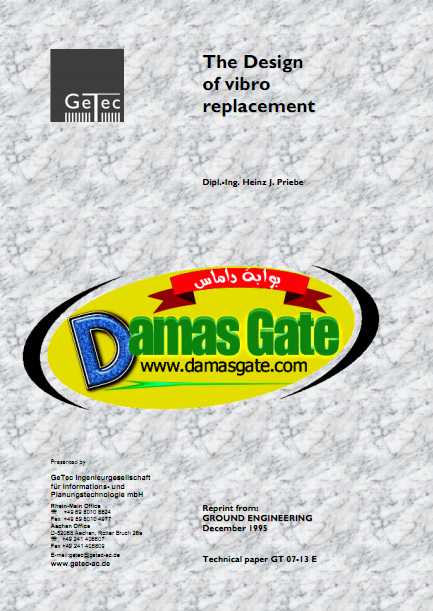The Design of Vibro Replacement

The Design of Vibro Replacement
Heinz J. Priebe
Vibro Replacement is an accepted method for subsoil improvement, at which large-sized columns
of coarse backfill material are installed in the soil by means of special depth vibrators. The
performance of this composite system consisting
of stone columns and soil, is not determinable
by simple investigation methods like soundings, and therefore, such methods are
not suitable for design purposes. However,
theoretically, the efficiency of Vibro Replacement
can be reliably evaluated. The method elaborated on a theoretical basis and described
in this contribution, is easy to survey
and adaptable to different conditions due to the
separate consideration of significant parameters.
Practically, it comprises design criteria for
all frequently occurring applications.
Introduction
Vibro
replacement is part of the deep vibratory compaction techniques whereby loose or soft
soil is improved for building purposes by means of special depth vibrators. These techniques
as well as the equipment required is comprehensively described elsewhere [1]. Contrary
to vibro compaction which densifies noncohesive
soil by the aid of vibrations and improves
it thereby directly, vibro replacement
improves non compactible cohesive soil by the
installation of load bearing columns of well
compacted, coarse grained backfill material. The
question to what extent the density of
compactible soil will be improved by vibro compaction,
depends not only on the parameters of the soil being difficult to determine, but also
on the procedure adopted and the equipment provided. However, the difficulty of a reliable
prognosis is balanced by the fact that
the improvement achieved can be determined easily
by soundings. With
vibro replacement the conditions are more or less revers. Considerable efforts only like
large-scale load tests can prove the benefit of stone columns. However, a reliable conclusion
can be drawn about the degree of improvement which results from the existence of
the stone columns only without any densification of the soil between. This is possible because
the essential parameters attributable to
the geometry of the layout and the backfill material
can be determined fairly good. In such a prognosis the properties of the soil, the equipment
and the procedure play an indirect role only and that is mainly in the estimation of
the column diameter. Basically,
the design method described herewith was developed some twenty years ago and published
already [3]. However, in the meantime it came to several adaptions, extensions and
supplements which justify a new and comprehensive description of the method. Nevertheless,
the derivation of the formulae is renounced with reference to literature.
Download
http://s18.alxa.net/s18/srvs2/01/The...eplacement.rar